#honestly i think his colors being less saturated following the first movie kind of symbolizes his mental health
Explore tagged Tumblr posts
Text
Do y'all think Branch started dying his hair after the first trolls movie?
#trolls#trolls branch#honestly i think his colors being less saturated following the first movie kind of symbolizes his mental health#aka his normal isnt a vibrant as everyone else#branch is neurodivergent is what im getting at#however the idea that he dies is hair is so fucking funny to me
11 notes
·
View notes
Text
D-Views: Aladdin (with guest input!)
Hi, everyone! Welcome to another installment of D-Views, my on-going written review series where I take a look at Disney-produced and/or owned properties, as well as occasionally non-Disney films that were influenced by Disney’s success! For more of these reviews, you may consult my “Disney reviews” tag, where I’ve discussed such films as Treasure Planet, Star Wars Episode III: Revenge of the Sith, and Dreamworks’ The Prince of Egypt!
Today I’ll be doing something a little different. In lieu of the live-action Aladdin remake premiering in less than two weeks, I decided it’d be best to re-watch the original 1992 classic, and I invited two of my good friends, Christina and Jen, to help me analyze it. I will note any of their input when it arises, and hopefully you’ll enjoy hearing three voices for the price of one!
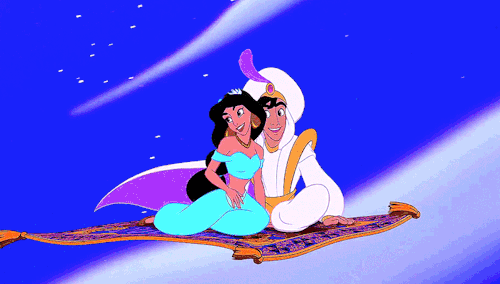
Aladdin was released in the midst of the Disney Renaissance in the 1990′s, sandwiched between the landmark hits Beauty and the Beast and The Lion King. Out of Disney’s biggest blockbusters, Aladdin is easily the most “of its time” -- it relies on pop culture references for its humor and uses era-specific slang (i.e. ”NOT!” and “Made you look!”) more than most Disney films do and features a celebrity voice in a prominent role, which was quite uncommon, compared to previous Disney projects. (The best examples I can think of prior to this was having John Hurt, Peter Ustinov, and Vincent Price play villains in The Black Cauldron, Robin Hood, and The Great Mouse Detective, but...yeah, as amazing and well-renown as those men are, they weren’t insanely popular media stars of the time the way that Robin Williams was.) One could attribute this “hipper” aspect at least in part to Jeffrey Katzenberg, who was head of Disney’s animation department at the time, and Disney CEO Michael Eisner, both of whom put a lot of focus in following what was popular and marketable. (Katzenberg later put all of his attention and focus on molding Pocahontas into a historical-fiction retelling of Romeo and Juliet as he assumed a forbidden love story would be a hit, while Eisner kicked The Rescuers Down Under to the curb a year before Beauty and the Beast came out all because it didn’t break the box office opening weekend.) Fortunately the approach paid off and Aladdin was a big success, fueling two direct-to-video sequels, a spin-off TV series, and a show at Disney’s California Adventure that transformed into a full Broadway musical. Even now it’s still very well-loved by Disney fans, many of whom are now looking forward to the live-action remake coming out this month. As my followers might know, I’m still very on-the-fence about the remake myself, as I haven’t reacted very warmly to Disney’s other recent live-action remakes, but my two cohorts Jen and Christina are much less cynical about the prospect, so hopefully any commentary we might make about what we’ve learned about the remake compared to the original will be minimal. Now that our context is framed, let’s board this magic carpet of a movie and see where it takes us!

To start with, Arabian Nights is just such a fantastic musical introduction to this story! Aladdin was the last project that lyricist Howard Ashman worked on before his premature death in 1992, and like in the rest of his work, the word play in the songs he wrote for this movie (Arabian Nights, Friend Like Me and Prince Ali) is just masterful. Arabian Nights in particular just emanates “adventure” -- it was later used as the opening theme for the Aladdin TV series, and it got me so pumped up whenever I watched it, just as much as it probably excited those who first saw the movie in theaters. Fun fact: while listening to the intro, one might notice the names Ted Elliot and Terry Rossio credited as two of the film’s screenwriters, alongside directors John Musker and Ron Clements -- down the road, Elliot and Rossio would also write the screenplay for The Road to El Dorado, join the writing team for Shrek, and be the main writing force behind the Pirates of the Caribbean films.
As much as I rarely go for films that market themselves as comedies, I feel like Aladdin handles its comedy really well. From the beginning, we see the comedic, spontaneous tone in the peddler’s narration scene, and that tone is taken on by Gilbert Gottfried as Iago until Robin Williams reappears as the Genie later. It makes it so that, unlike Mulan where the comedy kind of starts and ends with Mushu, the comedy is a constant fixture in the story, never distracting from the plot and never feeling out of place.
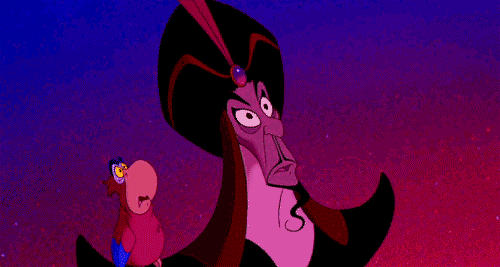
One niche interest of mine that I rarely get to delve into is color psychology, and oh BOY, does this film give me a lot to talk about there! Aladdin’s production designer, Richard Wende, used a very simple, yet striking color palette for the film that favors blues, reds, and golds. The effect is a beautifully lush setting while maintaining a “desert” feel: any greens that appear really stick out, like when Aladdin and Genie arrive in an oasis after escaping the Cave of Wonders. It also makes it so that when the background is mostly red or gold, any blue shades draw focus, or when the scene takes place at night and is mostly shades of blue, anything red or gold likewise draws focus. This post goes into the color symbolism more deeply, but generally blue is representative of good characters, while red represents evil, with gold being a sort of middle ground. Primary colors often are used in properties marketed toward children (ex. Team Valor/Instinct/Mystic in Pokemon Go, Snow White having all three colors on her dress), so it’s understandable that so many kids from the 90′s gravitated toward this movie, but the palette never feels restricted or simple. The deep, saturated fusion of reds and blues and reds and yellows creates a lot of texture despite the limited color range, and it beautifully communicates the heat of the locations and creates a unique visual style for the film. I’ve noticed that in the trailers for the remake, this color symbolism was discarded in favor of a more “Bollywood” look, not unlike how the Beauty and the Beast remake likewise ignored the color symbolism of Belle being the only villager to wear blue (which accents how much she stands apart from the crowd) and decided to dress a lot of people in blue during the opening number Belle. I can only hope the decision means the film is just choosing to make Agrabah more like India than Arabia, rather than this just being a stylistic choice with no substance, but I think the subtle color psychology in the original film is very clever short-hand for the audience, even if they’ll likely not be able to consciously express how the color palette affected their viewing experience.
As Jafar and his stooge Gazeem come across the Cave of Wonders, I’m reminded of how awesome the Cave’s design is. It was made primarily with CG animation, yet the CGI is never distracting: on the contrary, it fuses together beautifully with the rest of the hand-drawn background. Even the sandy texture on the Cave is very well rendered. Christina also noted a neat detail I hadn’t picked up on before: the tiger head has an earring in one ear, just like the Genie whose lamp lives inside the Cave!

After the Cave of Wonders devours Gazeem, declaring that it will only allow the “diamond in the rough” inside, we meet our title character and resident “diamond,” Aladdin. Voicing Aladdin is Scott Weinger, or Steve of Full House fame, who brings such charm, energy, and personality to the role. I honestly think it’d be hard for anyone else to match the sheer likability rippling out of Scott’s voice. Accompanying Weinger and Robin Williams in this stellar cast are Broadway actor Jonathan Freeman as Jafar (who has since gone on to play the character in everything from TV shows to the Broadway musical), raucous comic Gilbert Gottfried as Iago, and three voice-acting legends -- Frank Welker (who voices Shaggy and Scooby Doo) as Abu and Rajah; Jim Cummings (the current voices of Winnie the Pooh and Tigger) as Razoul; and Corey Burton (who is best known for playing Ansem the Wise in Kingdom Hearts) as Prince Tiger-Fucker Achmed. Even Jasmine, who was voiced by the at-the-time-fresh-faced actress Linda Larkin, had her singing voice done by Broadway legend Lea Salonga, fresh off her success premiering the title role in Miss Saigon. Even though many of these names aren’t celebrities like Robin Williams, and so I would hesitate to call this an “all-star cast” exactly, it doesn’t change how much talent was accrued by Disney’s casting agents!
Unlike most main characters in a Disney musical, Aladdin doesn’t get a full solo number to call his own. Originally Howard Ashman wrote a song for Aladdin called Proud of Your Boy, where Aladdin sings to his mother (who played a large role in early drafts of the story) about how he’ll make good for her. Unfortunately the story’s focus on Aladdin and his mother’s relationship ended up taking focus away from Aladdin and Jasmine’s romance and Aladdin’s character arc to accept himself, so the screenwriters ultimately had to cut the mother character from the story, at which point the song no longer fit. The decision was very difficult for the filmmakers at the time, given that it was one of the last things Ashman wrote and it’s such a beautiful, raw song, but I ultimately think it was the right decision. Putting Aladdin on his own with no one but Abu for company and giving Jasmine no emotional support outside of her naïve, misguided father and her pet and only friend Rajah I think goes a long way to explain why they’re such kindred spirits. Aladdin and Jasmine each become the friend and support that the other needed. (This is also why Christina and I are concerned about the inclusion of a servant/friend for Jasmine, as the choice would likely weaken any rationale Jasmine could have for leaving the palace and for connecting so instantly with Aladdin.) Plus I think Aladdin’s reprise of One Jump Ahead is just as beautifully raw as Proud of Your Boy, just with a slightly different message and less words. I really feel Aladdin’s frustration and yearning for something better, and Aladdin’s singing voice Brad Kane is able to stuff so much pathos into such a short tune that a longer song isn’t even necessary. And fortunately Proud of Your Boy was later utilized in the Broadway musical version of Aladdin, so it got its dues eventually.
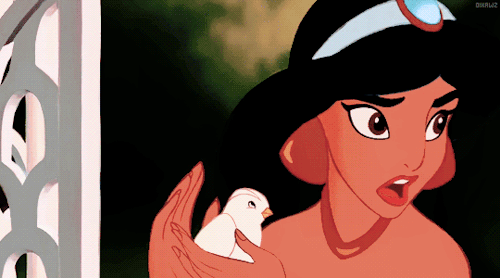
At the palace, we meet our heroine, Jasmine, who was Christina’s favorite Disney character as a kid and who I personally think is the prettiest of the Disney princesses. Jasmine was designed by supervising animator Mark Henn, who modeled her after a picture of his little sister, which honestly is so sweet that I can’t stand it. What I really like about Jasmine in comparison to other Disney princesses is that she is fiery, but clever: determined, but calculating: proud, yet compassionate. It’s this balance that makes her interesting: in my mind, Jasmine is the ultimate Slytherin Disney princess (with just as Slytherin of a prince!), because unlike Ariel, she isn’t reckless in her rebellion. What’s also very cool about Jasmine is that her circumstances are a perfect contrast to Aladdin, placing them in a more romantic Prince and the Pauper set-up where they envy each other, and yet they want the same thing: freedom. In fact, all of our protagonists do -- namely, Aladdin, Jasmine, and Genie. Aladdin wants freedom from his poverty. Jasmine wants freedom from her privilege. Genie wants freedom from his purpose. They all have different cages, but they all want to be free to live their own lives, and it’s through Aladdin learning to empathize with Jasmine and Genie and see their respective prisons as clearly as his own that he grows as a character. (For a video that delves into this thought process further, please consult this piece by ScreenPrism -- it’s just beautifully done!)
Throughout the film, three animals emerge over and over -- the cobra, the elephant, and the tiger. Tigers -- which we see not only in obvious examples like Rajah and the Cave of Wonders, but also as a carving in the back of the Sultan’s throne -- are generally associated with courage and heraldry, not unlike their feline cousins, lions. The heraldry aspect I think is most relevant here -- only one who is deemed worthy, namely Aladdin, may enter the Cave of Wonders and access the wealth of kings, and when Jasmine runs away from home, she leaves Rajah, a symbol of her noble heritage, behind. Elephants in comparison are associated with wisdom and more notably royal power. In the film, Abu is transformed into an elephant steed for Aladdin when he becomes Prince Ali, and even the Sultan sits in a throne decorated with a statue of an elephant. As for the cobra, it’s entirely connected to Jafar, first as his magic scepter and then as a form Jafar takes on himself. Snakes overall are associated with many things like healing, rebirth, eternity, and the dichotomy of good and evil, but cobras specifically are the most poisonous snakes on earth. Legends even claim that Cleopatra, the last Pharaoh of Egypt, committed suicide by cobra bite. I reckon that meaning is more than enough reason for it to represent Jafar.
Through the use of a bizarre storm-making machine powered by Iago running on a treadmill-like wheel that Christina, Jen, and I thoroughly don’t understand and kind of find hilariously ridiculous, Jafar is able to discover the identity of the elusive “diamond in the rough.” He then sends the guards out to arrest Aladdin so as to coerce him into aiding him in his goal to enter the Cave, but in the process gets caught by Jasmine as he’s exiting one of the secret passages. Jen brought up the lovely point that Jafar seems to be the only person who knows about these passages in the palace, even though the Sultan presumably was raised in the palace just like Jasmine was -- this isn’t necessarily a problem, but it does make both her and me want to know the story behind this! Was Jafar basically raised in the palace too? Did Jafar partially create those passages? Were they forgotten after years of non-use and Jafar came across them by chance? It seems like there could be some fun explanation here, if someone wanted to write a fic or fan theory about it.

Okay, I really don’t want to express my concerns about the remake yet again, but I just have to say this flat-out -- there is no way that Abu in the remake could be as funny as he is in the animated film. Let’s be honest, CG characters in live-action films are almost never very charming if they’re more on the cartoony side compared to the so-called “realistic” world they’re supposed to inhabit. You can have very likable, well-developed CG characters -- just look at Aslan in The Chronicles of Narnia -- but he wasn’t solely comic relief the way Abu is, and Abu’s comedy in particular relies on a lot of cartoon-like squash and stretch that would be difficult to recreate in CG for a live-action movie. Best case scenario, you’d have something like Pip in Enchanted, which is only irritating and visually out-of-place sometimes, but alternatively, you might get something like Alvin and the Chipmunks (where the humor falls flat), Dobby in Harry Potter and the Chamber of Secrets (where it’s clear he was never actually there the whole time), and/or the enchanted objects in the live-action Beauty and the Beast (where the characters end up looking creepy, like something out of the Uncanny Valley). Basically if they want Abu to work in the live-action setting, it’s likely they’d have to make him more like an actual animal, which as I said would make it so he is a lot less funny.
Anyway, not long after Abu unlocks Aladdin’s shackles, Jafar arrives to bust him out, disguised as an old man. Just as Jafar’s storm-making machine makes no sense, the three of us all concluded that his disguise makes no sense. Not only does Jafar suddenly look a good foot and a half shorter, which even with him crouching shouldn’t be possible, but he’s changed his teeth with no visible dentures (which would’ve slurred his speech anyway) and he can get rid of all of the white hair and beard he put on just by ripping off the beard in a single gesture. As Jen brought up, even the Evil Queen used a potion to turn into the Hag: if Jafar had used magic, these sort of physical changes would make sense, but he didn’t.
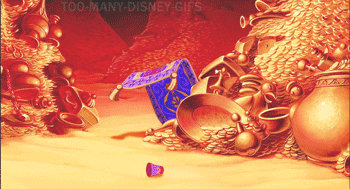
Back to the Cave of Wonders again, and now I get to talk about one of the most revolutionary aspects of Aladdin: the Magic Carpet. Our sweet little Carpet is a perfect fusion of CG and hand-drawn animation -- supervising animator Randy Cartwright drew the outline and tassels of Carpet with so much personality and silent comedy, and rather than have to animate Carpet’s detailed pattern in every single frame as the fabric folded and contorted, the pencil tests were handed to the CG artists, who melded the pattern perfectly to the line work, making it one perfectly cohesive character. Carpet’s pattern also has allusions to different parts of the film, including the Cave of Wonders, the magic lamp, and the flames that appear when Abu touches the red gem. Even if the technology of CG animation is much more advanced now than it was in 90s, it doesn’t change how seamless the finished result is.
As mentioned, the Cave doesn’t remain safe for our hero very long. When Abu snatches up a gem after being warned not to touch anything, the whole place starts to fall apart, raging with lava and fire. Christina brought up the question of why the Cave would allow Abu inside, since he wasn’t the diamond in the rough (yes, Abu was hidden in Aladdin’s vest, but the Cave was magical, did it really not know he was there?), but I almost wonder if it was an issue of Aladdin having trusted Abu when he shouldn’t have, which would end up being the true mistake in this scenario. Regardless, the CGI in this particular escape sequence is some of the more outdated material of the film. The flight on Carpet is still kind of fun, as it probably would make for a very exciting thrill ride, but it still looks incredibly fake, especially in comparison to other CG elements used in other scenes. Honestly, I’d say this Cave chase and the tower used in the “ends of the earth” sequence later are the worst instances of outdated CGI in this movie.

And finally, at long last, we get to the big, blue guy himself, the Genie. As much as I wouldn’t say Genie steals the show, as Aladdin has such a likable hero and heroine and an excellent villain, Jen, Christina, and I will say categorically that Aladdin would not be as good of a movie as it is without Genie and without Robin Williams. The directors Ron Clements and John Musker wrote the character with Robin in mind, but thought there’d be no way they’d ever get him -- fortunately Eric Goldberg, the supervising animator for Genie, got the idea to make an animation of Genie speaking a piece of one of Robin’s comedy routines, and the animation amazingly won Robin over and got him on board. And really, it is that flawless combination of Robin’s acting and Goldberg’s animation that really makes Genie as likable as he is. Even Robin’s humor, which still is very funny, is not what makes Genie as great of a character as he is, in my opinion -- if anything, I’d say it’s how much sincerity Robin gives the role. Genie is never a sidekick in this movie, as he has his own distinct motivations and feelings separate to the main character and their goals, and Robin just makes you feel so much for Genie and his own desire for freedom. One quote of Genie’s that has stuck with me since I was a kid thanks to Robin’s beautiful delivery is “To be my own master -- such a thing would be greater than all the magic and all the treasures in all the world.” It makes it so his humor is a sign of how resilient Genie is, despite how unhappy his circumstances are, which is something I understand very well as someone who has suffered from depression and I’m quite sure Robin himself understood very well too. I think it’s why so many people found Robin so likable and felt so much for the characters he portrayed over the years.
Speaking on Friend Like Me specifically, I’m afraid I’ll have to go off on a bit of a tangent and share a story with all of you. The day that Robin Williams passed away, I was working at the World of Color show at Disney’s Calfornia Adventure. When the Friend Like Me segment came on, I danced along to the music while in the walkway outside the show, trying to keep the grief off of my face and just make others happy, the way Robin used to. As the segment ended, everyone applauded like crazy. Then, all of a sudden, we Cast Members became aware of a strange, sputtering, almost sobbing sound. One of the show fountains in the water had gotten out of alignment and it sputtered softly in the background as the next segment (Touch the Sky) began, before after a minute slowly quieting and coming to a stop. It was as if the show was crying for Robin, this person who had given so much joy to so many people. And this, among other reasons, is why I feel so very sorry for poor Will Smith, who somehow has to try to fill the shoes that Robin wore. Jen, Christina, and I aren’t very optimistic about his prospects (I still personally might have offered the role to Wayne Brady instead, given that he can sing, he has done comedy, and he worked with Robin in the past), as even Dan Castellanetta, who voiced Genie in the Aladdin TV series, was never able to match Robin no matter how hard he tried.
On the note of Genie’s motivation, as well, we hear about it in a scene accompanied by the beautiful instrumental “To Be Free.” It’s one of my favorite pieces of instrumental music from the film, which became one of Christina’s favorite songs from the Aladdin musical, To Be Free, which is a solo sung by Jasmine. As very pretty and appropriate the song is from Jasmine, I do also really appreciate the number accompanying Genie’s monologue. The instrumental comes across as more spontaneous and thoughtful, like it’s making itself up as it goes along, until it gets to the sincere, meaningful line about freedom, at which point the melody that inspired the song To Be Free's chorus starts.
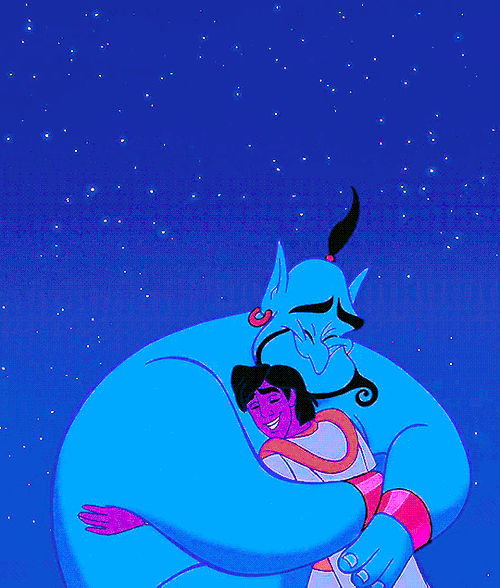
Another neat touch with Genie is his use of Yiddisms, such as “punim,” meaning face. Of course, Genie’s animator Eric Goldberg is Jewish, and the idea of Genie being Jewish as well I just find so unbelievably charming, particularly when you place him in an Arabian-like setting full of (presumably) Muslim characters, given that the Sultan at one point references Allah. Therefore Genie and Aladdin’s (adorable) friendship could be thought of as a friendship between a Jewish person and a Muslim! I think that’s really cool!
We return to the palace, where the Sultan scolds Jafar for Aladdin’s supposed execution, only for Aladdin to burst onto the scene, dressed as the dashing Prince Ali. During this scene, Christina noted the fun juxtaposition of Jafar’s fashion choices compared to the Sultan, Genie as a human, and Aladdin as Ali. All of them wear very similar robes and turbans, but the Sultan, Genie, and Aladdin wear turbans with more rounded, floppy feathers, which Jafar’s feather is sharp and straight. Aladdin’s and the Sultan’s feather even flop into their faces sometimes, whereas Jafar’s is rigid as a board. As Jen likewise pointed out, Jafar’s design gives him this pointed, slender look not unlike Dr. Facilier in future Disney project The Princess and the Frog. The shoulder pads on his shoulders also serve to give him this sort of sharp “T” shape, contrasted to the more rounded and well-proportioned characters. Couple that with a black/red color scheme that contrasts the more saintly tannish-white of the other three, and it really does communicate the “black cloud” nature that Jafar’s supervising animator Andreas Deja wanted to give the character, to compliment the “Severus Snape” level of dry sardonicism Jonathan Freeman gave the character.
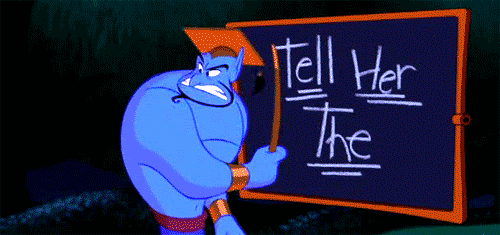
Even though the Sultan is very impressed by “Prince Ali,” Jasmine most certainly is not. Genie counsels Aladdin (with a few outdated pop culture references) that he should tell her the truth -- the nice thing about the pop culture references is that, really, even if you don’t get the jokes, you can still understand them, and the jokes still drive dialogue and plot forward enough that those lines don’t feel like a waste of time. I mean, I didn’t get most of the jokes as a kid, and it didn’t hurt anything for me -- I still thought the Genie was funny because of his comedic timing and odd voices. (Oh yes, and since Jen brought this up while we were watching this -- Aladdin does not say “take off your clothes” while up on Jasmine’s balcony: the line that Weigner improvised for when Aladdin is trying to shoo Rajah away is “take off and go.” Get your brains out of the gutter.)
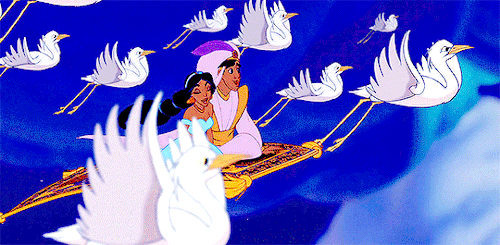
Fortunately Aladdin is able to soften Jasmine enough that she gives him a chance, and the two go on a magic carpet ride (a.k.a. the fastest world tour ever, as Christina described it! LOL). Accompanying this scene is, in my opinion, the single most romantic song in the Disney canon. A Whole New World was the very first song Alan Menken and Tim Rice wrote together. After the loss of his good friend and most constant collaborator, Howard Ashman, Menken was very nervous about working with someone else. Fortunately, as soon as he and Tim Rice met, they came together pretty quickly while working on the aforementioned love song, which ended up taking some inspiration from their circumstances as new collaborators in its melody and lyrics. So yes, one could listen to this song and some of its lines -- a new, fantastic point of view -- but when I’m way up here, it’s crystal clear that now I’m in a whole new world with you -- unbelievable sights, indescribable feelings -- with new horizons to pursue -- every moment, red letter -- let me share this whole new world with you -- as being not just about these two characters falling in love, but also about a brand new, exciting friendship.
Aladdin and Jasmine connect, Jafar is banished from the palace, and the Sultan blesses Jasmine’s decision to court “Prince Ali” -- but yeah, just as everything looks like everything’s coming up roses, things start to fall apart when Aladdin breaks his promise to set Genie free. (Another fun story: when I first saw this scene in the Aladdin Musical Spectacular at Disney California Adventure way back in the day, I couldn’t stop myself from yelling “BOO!” from the audience. The people around me giggled. Then the actor playing Genie, without looking away from the actor playing Aladdin, raised a hand and pointed out at the audience. “You hear that?” he said. “That’s my THOUGHTS.” I died laughing.) But yes, thanks to Aladdin’s mistake, Jafar is able to take advantage of the situation and snatch Genie for himself, singing his own quasi-solo, Prince Ali (reprise). Like Aladdin, Jafar doesn’t get a full number to call his own, but fortunately he doesn’t end up needing one: Prince Ali (reprise) is more than powerful enough on its own, and it concludes with the most amazing, deranged laugh in Disney history. Really, as good as some other Disney villain laughs are, I would say that Jafar’s is easily the best.
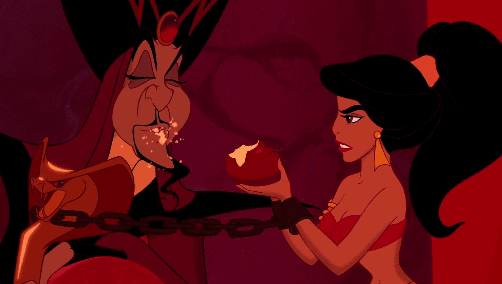
Jafar becomes the Sultan of Agrabah, imprisoning both Jasmine and the Sultan and banishing Aladdin to the ends of the earth. Even if Jasmine’s a prisoner, though, she is no damsel: in Christina’s words, she’s the Princess Leia to Jafar’s Jabba the Hutt, clever and proud as ever and ready to do whatever is necessary to break free...even if it means kissing our villain in order to distract him long enough for Aladdin to try to snatch back the lamp. (Insert a cringe from all three of us here.) Alas, the ruse fails, and Jafar discovers that Aladdin has returned alive and well. The “Battle” track used for this climax is just epic accompaniment, easily being up there among some of the best “final confrontation” instrumental tracks in Disney history like Sleeping Beauty’s “Battle With the Forces of Evil” and The Great Mouse Detective’s “Big Ben Chase.” The visuals as well are also thrilling -- speaking as someone with acute ophidiophobia, Jafar turning into a giant cobra is pretty terrifying.
Despite all of the odds being against him, our diamond in the rough street rat nonetheless is able to outsmart Jafar, and Jafar, tricked into the form of a Genie, is imprisoned in his own pitch black lamp, possessing all of the power he longed for but ignorantly sacrificing the power of autonomy he had already. (As Jen said, and I quote, “Karma, bitch!”) I just adore how Aladdin outwitted Jafar too: not only does it really suit his Slytherin personality to win through craftiness rather than just brute force, but it also perfectly showcases the difference between Aladdin and Jafar: namely, that Aladdin knows empathy, and Jafar does not. Jafar only sees what Genie has that he doesn’t have, supreme magical power, and longs to possess it -- Aladdin sees Genie’s circumstances fully and knows that he is both amazingly powerful in a magical sense and utterly powerless when it comes to making his own choices.
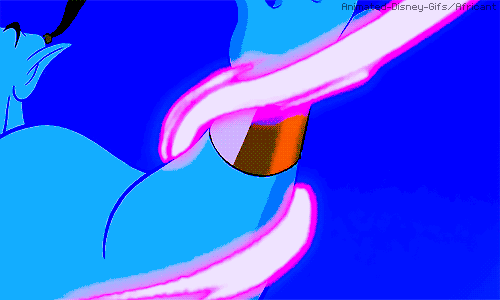
Accompanying the film’s resolution is the beautiful instrumental “Happy End in Agrabah,” which dips into lighthearted whimsy, resignation, bittersweet joy and exhilaration, alongside echoes of both “To Be Free“ and A Whole New World. Aladdin gives Genie his greatest desire -- his freedom -- and in the process makes, in Jen’s words, the most selfless wish you could make...for only a diamond in the rough would make a wish for someone else, not for himself. And as Jen also pointed out, the Sultan follows Aladdin’s lead, giving Jasmine her freedom just as Aladdin gave Genie his. Our story ends with all of our protagonists earning the freedom that they’ve so longed for -- the freedom to achieve their own happiness -- through their love of each other.
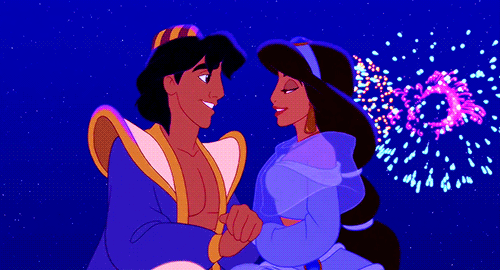
Aladdin may be very “of its era” from a humor point of view, but it’s a movie that truly becomes more resonant with age. When Jen, Christina, and I were kids, we all enjoyed this movie’s flights of fantasy, humor, characters, and songs, but as adults, we can feel for these characters and their desire for freedom more than ever. We can understand how similar these individual characters are, and how even though they’re all in different prisons with different advantages and disadvantages, they all need the same key to unlock their cages -- love and empathy. However much the new Aladdin film diverges from the animated version, I only hope that they remember that core of the movie and how it is integrated into the entire story, from how much Aladdin wishes people would “look closer” when looking at him to Genie’s last words to Aladdin being that “no matter what anybody says, [Aladdin will] always be a prince to [Genie.]” And if it doesn’t, well, we still have the 1992 original...
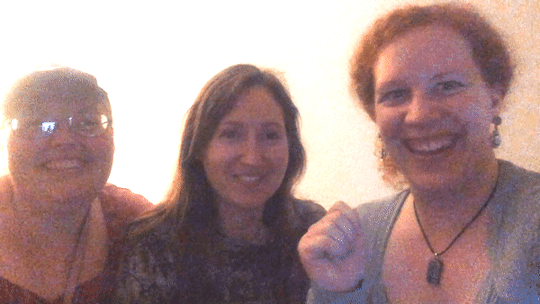
...and Christina, Jen, and I give that movie three thumbs up!
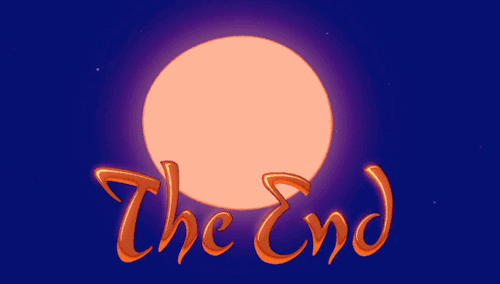
#d-views#disney reviews#disney#aladdin#reviews#tory jen and christina watch together!!#opinion#analysis#oh boy here i go#aladdin (2019)
21 notes
·
View notes